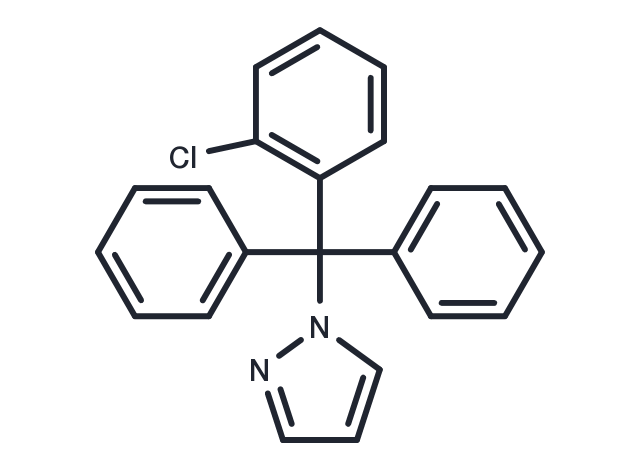Powder: -20°C for 3 years | In solvent: -80°C for 1 year


TRAM-34 (Triarylmethane-34) (Kd=20 nM), an effective and specific inhibitor of the intermediate-conductance Ca2+-activated K+ channel (IKCa1, KCa3.1), does not block cytochrome P450. The selective activity of TRAM-34(TRAM 34) is 200 to 1500-fold than other ion channels.

| Pack Size | Availability | Price/USD | Quantity |
|---|---|---|---|
| 10 mg | In stock | $ 43.00 | |
| 25 mg | In stock | $ 81.00 | |
| 50 mg | In stock | $ 148.00 | |
| 100 mg | In stock | $ 195.00 | |
| 200 mg | In stock | $ 253.00 | |
| 500 mg | In stock | $ 425.00 | |
| 1 mL * 10 mM (in DMSO) | In stock | $ 48.00 |




| Description | TRAM-34 (Triarylmethane-34) (Kd=20 nM), an effective and specific inhibitor of the intermediate-conductance Ca2+-activated K+ channel (IKCa1, KCa3.1), does not block cytochrome P450. The selective activity of TRAM-34(TRAM 34) is 200 to 1500-fold than other ion channels. |
| Targets&IC50 | IKCa1:20 nM (Kd) |
| In vitro | Unlike clotrimazole, TRAM-34 selectively inhibits IKCa1 without blocking cytochrome P450 enzyme (CYP3A4). TRAM-34 potently inhibits cloned IKCa1 channel in IKCa1-transfected COS-7 cells as well as native IKCa currents in human T lymphocytes and T84 cells with Kd of 20 nM, 25 nM, and 22 nM, respectively, more potently than clotrimazole with Kd of 70 nM, 100 nM, and 90 nM, respectively. TRAM-34 exhibits 200- to 1,500-fold selectivity over other ion channels such as KV, BKCa, SKCa, Na+, CRAC, and Cl- channels. TRAM-34 significantly inhibits anti-CD3 Ab or PKC-activator PMA plus calcium-ionophore ionomycin-induced activation of human T lymphocytes with IC50 of 295-910 nM and 85-830 nM, respectively. TRAM-34 (5 μM) does not inhibit cell viability of human T lymphocytes or several cell lines. [1] TRAM-34 significantly inhibits EGF-induced IKCa1 up-regulation, and EGF-stimulated proliferation of A7r5 cells with IC50 of 8 nM. [2] TRAM-34 treatment inhibits proliferation of human endometrial cancer (EC) cells and blocks EC cell cycle at G0/G1 phase. [3] |
| In vivo | TRAM-34 treatment at ~500-1,000 times the channel-blocking dose (0.5 mg/kg/day) for 7 days is nontoxic to mice. [1] Administration of TRAM-34 at 120 mg/kg/day significantly reduces intimal hyperplasia by ~40% in a rat model of balloon catheter injury (BCI). [2] Consistent with it's in vitro role in inhibiting the proliferation of EC cells, TRAM-34 treatment at 30 μM slows the development of HEC-1-A tumor in vivo. [3] |
| Kinase Assay | Electrophysiology: The human IKCa1 is cloned and expressed in COS-7 cells. Cells are studied in the whole-cell configuration of the patch-clamp technique. The holding potential is 280 mV. The internal pipette solution contains: 145 mM K+ aspartate, 2 mM MgCl2, 10 mM Hepes, 10 mM K2EGTA, and 8.5 mM CaCl2 (1 μM free Ca2+), pH 7.2, 290-310 mOsm. To reduce currents from the native chloride channels in COS-7 cells, Na+ aspartate Ringer is used as an external solution: 160 mM Na+ aspartatey/4.5 mM KCl/2 mM CaCl2/1 mM MgCl2/5 mM Hepes, pH 7.4/290-310 mOsm. IKCa currents in COS-7 cells are elicited by 200-ms voltage ramps from -120 mV to 40 mV applied every 10 seconds and the reduction of slope conductance at -80 mV by TRAM-34 taken as a measure of channel block. |
| Cell Research | Cells are exposed to TRAM-34 for 48 hours. After 48 hours, cells are harvested by suction (suspension cells) or by trypsinization (adherent cell lines), centrifuged, resuspended in 0.5 mL PBS containing 1 μg/mL propidium iodide (PI), and red fluorescence measured on a FACScan flow cytometer. The percentage of dead cells is determined by their PI uptake, 104 cells of every sample being analyzed. (Only for Reference) |
| Synonyms | Triarylmethane-34, TRAM 34 |
| Molecular Weight | 344.84 |
| Formula | C22H17ClN2 |
| CAS No. | 289905-88-0 |
Powder: -20°C for 3 years | In solvent: -80°C for 1 year
DMSO: 3.5 mg/mL (10 mM), Heating is recommended.
You can also refer to dose conversion for different animals. More
bottom
Please see Inhibitor Handling Instructions for more frequently ask questions. Topics include: how to prepare stock solutions, how to store products, and cautions on cell-based assays & animal experiments, etc.
TRAM-34 289905-88-0 Membrane transporter/Ion channel NF-Κb IκB/IKK Potassium Channel Triarylmethane-34 Inhibitor KcsA inhibit TRAM34 TRAM 34 inhibitor
